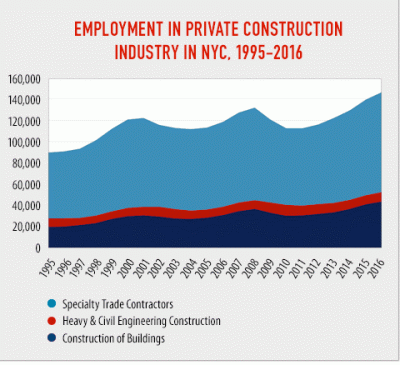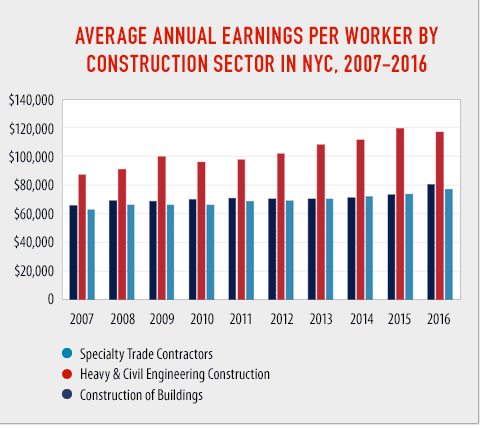
New york city construction employment surpassed 140,000 in 2016
Average Wages for Construction Workers Increased by Highest Rate Since 2007
New York City construction industry employment rose for the fifth consecutive year in 2016, surpassing 140,000 for the first time in at least four decades, according to a New York Building Congress analysis of New York State Department of Labor employment statistics available since 1975.
 |
|
| Sources: New York State's Current Employment Statistics (CES) and Quarterly Census of Employment and Wages |
In addition, the average annual wages earned by these workers increased by an estimated 5.4 percent in 2016, which represents the highest annual percentage increase since 2007, when wages increased 6.4 percent, and the first time since 2008 that wages had increased by more than 3 percent in any single year.
The Building Congress analysis is based on a review of New York State's Current Employment Statistics (CES) and Quarterly Census of Employment and Wages (QCEW).
Employment
New York City produced an average of 146,200 construction jobs in
2016, a 5 percent increase from 2015, when 139,200 jobs were created.
Construction industry employment reached 129,100 in 2014 and 122,100 in
2013.
Based on an analysis of jobs data from the first half of this year, the Building Congress estimates construction employment will rise slightly further to 147,800 jobs in 2017.
The specialty trades sector, which includes plumbers and electricians, accounted for 93,900 jobs in 2016, up from 89,900 jobs in 2015. Workers involved in the construction of buildings accounted for 43,300 jobs last year, up from 41,000 the prior year. The heavy construction and civil engineering sector, which is primarily involved in major infrastructure projects, produced 8,900 jobs, up from 8,400 in 2015.
"Thanks to a virtually unprecedented building boom in both the residential and office sectors, the New York City construction workforce has grown by an impressive 30 percent over the past five years," said New York Building Congress President and CEO Carlo A. Scissura. "Just as importantly, about three-quarters of these well-paying jobs are going to residents of the five boroughs, further strengthening the city's economy and tax base."
 |
|
| Source: New York State's Quarterly Census of Employment and Wages |
Wages
The Building Congress estimates that average wages earned by New York
City construction workers increased from $76,100 in 2015 to $80,200 last
year. While the wages of city construction workers have increased each
year since 2004, the growth in compensation had been much more modest in
recent years. Industry workers overall earned an average of $74,100 in
2014, $73,000 in 2013, and $71,800 in 2012.
While the heavy construction and civil engineering workforce remains the highest paid in the industry, average wages actually declined for workers in this sector from $119,200 in 2015 to $116,800 last year. This workforce earned an average of $111,200 in 2014 and $107,900 in 2013. The decline in annual wages may have been associated with declines in overtime rather than a contraction in average hourly wages.
The New York City workforce involved in the construction of buildings experienced a dramatic 9.2 percent increase in wages from $73,300 in 2015 to $80,100 last year. These workers averaged $71,200 in wages in 2014 and $70,200 in 2013.
Workers employed by specialty trade contractors also got a bump in pay with wages that averaged $76,900 in 2016, up from $73,500 in 2015, $71,700 in 2014, and $70,300 in 2013.
"Like the rest of the job market, construction industry wages finally seem to be catching up to job growth after lagging behind for most of the economic recovery," added Mr. Scissura. "While this is great news for individual workers and their families, it remains to be seen what, if any, effect rising wages will have on the overall demand for construction services in New York City."


